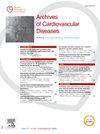Differential impact of C57BL/6 substrains on the development of type 1 cardiorenal syndrome
IF 2.3
3区 医学
Q2 CARDIAC & CARDIOVASCULAR SYSTEMS
引用次数: 0
Abstract
Introduction
C57BL/6 is one of the most important mouse strains for preclinical research. However, the two main substrains, C57BL/6 J and C57BL/6 N have developed over time genetic mutations that could lead to differences in response to pathology. The heart and kidneys are closely linked, and dysfunction of either organ can affect the other, leading to a pathological condition known as cardiorenal syndrome (CRS). Type 1 CRS is characterized by a primary acute cardiac injury, leading to a secondary renal disease. Although some studies have shown differences on the development of acute cardiovascular or renal diseases between these two substrains, the influence of the C57BL/6 background on the development of type 1 CRS remains poorly understood.
Objective
The goal of this project is to determine and compare the cardiac and renal outcomes and the development of type 1 CRS after a primary cardiac insult between the two main C57BL/6 substrains.
Method
Fourteen weeks old C57BL/6NRj (B6 N) and C57BL/6JRj (B6 J) male mice were subjected to permanent coronary artery ligation to generate acute myocardial infarction (MI) or sham surgery. Cardiac and renal functions were analysed by echography and transdermal glomerular filtration rate, 7 and 21 days after the surgery. Cardiac or renal remodeling analysis were performed after 21 days.
Results
In both substrains, left ventricular ejection fraction was reduced 21 days after acute MI as compared with their respective sham (P < 0.0001). After MI, both substrains significantly developed cardiac hypertrophy, as evidenced by the similar increase of heart weight (+25% in both groups, compared with their respective sham) and cardiomyocyte size (+31% in B6 J and +18% in B6 N, compared with their respective sham). Regarding the renal outcome, acute MI resulted in an increase in renal artery pulsatility index (+22% compared with sham), and a decrease in glomerular filtration rate (-20% compared with sham) only in B6 J mice, whereas both renal parameters remained unchanged in B6 N background.
Conclusion
Overall, our results show that an acute cardiac injury led to the same level of primary cardiac dysfunction in both B6 J and B6 N substrains, whereas only the B6 J develop a secondary kidney disease and a type 1 CRS.
C57BL/6亚型对1型心肾综合征发展的差异影响
c57bl /6是临床前研究最重要的小鼠品系之一。然而,随着时间的推移,C57BL/6 J和C57BL/6 N这两个主要的亚菌株发生了基因突变,可能导致对病理反应的差异。心脏和肾脏紧密相连,任何一个器官的功能障碍都会影响另一个器官,从而导致一种被称为心肾综合征(CRS)的病理状况。1型CRS的特点是原发性急性心脏损伤,导致继发性肾脏疾病。尽管一些研究显示这两个亚株在急性心血管或肾脏疾病的发展上存在差异,但C57BL/6背景对1型CRS发展的影响尚不清楚。目的:确定和比较两种主要C57BL/6亚型在原发性心脏损伤后的心脏和肾脏结局以及1型CRS的发展。方法采用14周龄C57BL/6NRj (B6 N)和C57BL/6JRj (B6 J)雄性小鼠永久性冠状动脉结扎致急性心肌梗死(MI)或假手术治疗。术后第7、21天采用超声和经皮肾小球滤过率分析心功能和肾功能。21天后进行心脏或肾脏重构分析。结果两种亚群在急性心肌梗死后21 d左心室射血分数均低于假手术组(P <;0.0001)。心肌梗死后,两种亚株均显著发生心肌肥厚,心脏重量增加(与假手术相比,两组均增加25%)和心肌细胞大小增加(与假手术相比,B6 J组增加31%,B6 N组增加18%)。关于肾脏结果,急性心肌梗死仅在B6 J小鼠中导致肾动脉搏动指数增加(与假手术相比增加22%),肾小球滤过率下降(与假手术相比减少20%),而在B6 N背景下,两项肾脏参数保持不变。总的来说,我们的研究结果表明,急性心脏损伤导致B6 J和B6 N亚株的原发性心功能障碍水平相同,而只有B6 J发生继发性肾脏疾病和1型CRS。
本文章由计算机程序翻译,如有差异,请以英文原文为准。
求助全文
约1分钟内获得全文
求助全文
来源期刊

Archives of Cardiovascular Diseases
医学-心血管系统
CiteScore
4.40
自引率
6.70%
发文量
87
审稿时长
34 days
期刊介绍:
The Journal publishes original peer-reviewed clinical and research articles, epidemiological studies, new methodological clinical approaches, review articles and editorials. Topics covered include coronary artery and valve diseases, interventional and pediatric cardiology, cardiovascular surgery, cardiomyopathy and heart failure, arrhythmias and stimulation, cardiovascular imaging, vascular medicine and hypertension, epidemiology and risk factors, and large multicenter studies. Archives of Cardiovascular Diseases also publishes abstracts of papers presented at the annual sessions of the Journées Européennes de la Société Française de Cardiologie and the guidelines edited by the French Society of Cardiology.
 求助内容:
求助内容: 应助结果提醒方式:
应助结果提醒方式:


